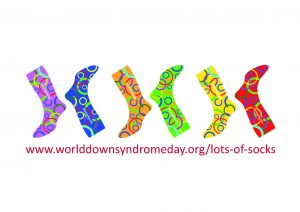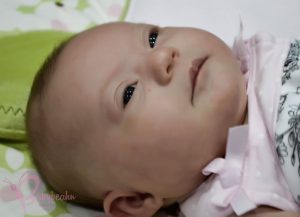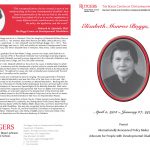
March 21 is World Down Syndrome Day! We gratefully acknowledge the courtesy of Down Syndrome International for their permission to reproduce their graphics.
March 21. That’s three twenty-one. These numbers are symbolic of the medical name for Down syndrome: trisomy 21. In humans, each cell normally has 23 pairs of chromosomes, which contain the person’s genetic makeup. In people with Down syndrome, the 21st chromosome has three rather than the usual two copies. We’ll discuss that in a moment, when we talk about wearing colorful socks. Down syndrome is the most common trisomy condition. Such seemingly tiny genetic variations can have a tremendous impact on a person. (A prime example is the 23rd chromosome: females have two copies of the X chromosome and males have one X and one Y.) Thus, World Down Syndrome Day 2018, people we serve everyday in our residential and community-based respite programs.
World Down Syndrome Day

This little boy with Down syndrome enjoys a life of inclusion in the community. Photo by: Vanellus, via Wikimedia Commons
The theme for World Down Syndrome Day for 2018 is What I Bring to My Community. According to Down Syndrome International, “All people with Down syndrome must have opportunities to contribute to the community and live valued lives, included on a full and equal basis with others, in all aspects of society. People with Down syndrome can and do bring so much to the community, wherever they live around the world, when given the opportunity.”
In addition, Down Syndrome International will hold a conference on March 21 at the United Nations World Headquarters, New York, as well as in Geneva. The conference and campaign will address four questions:
- Why it is important for people with Down syndrome and their advocates to speak up and influence policy makers at all levels?
- What key policies affect the lives of people with Down syndrome? How can these policies ensure full inclusion in society?
- How can advocates become involved?
- How can we empower people with Down syndrome, along with those supporting them, to advocate for themselves?
People with Down syndrome, their friends, and peers will describe how they can and do make meaningful contributions to the community throughout their lives. The objective is to tackle negative attitudes and a lack of knowledge about the potential of people with Down syndrome, which prevents them from having opportunities to make contributions.
The Power of Positivity

#LotsOfSocks, courtesy of Down Syndrome International
Socks… #LotsOfSocks! One way in which many people are spreading not only awareness of Down syndrome, but also good cheer is by wearing cheerful, brightly colored socks. No, they do not need to match. In fact, some people are going beyond the traditional pair of socks by wearing a third sock, in recognition of that extra chromosome.
The last word: It is easy to see why this video has gone viral. You will recognize the song, which Christina Perri has graciously allowed these 50 moms and 50 children to use. The theme is “Wouldn’t Change a Thing.” The page on YouTube has further information on the video and song.
National Trisomy Awareness Month
Most of us are born with 23 pairs of chromosomes, for a total of 46. These chromosomes include DNA and other genetic building blocks. Some people, however, are born with a trisomy condition, that is, an extra copy. Trisomy can lead to a variety of problems, including physical and intellectual and developmental disabilities. March is Trisomy Awareness Month: the three most common trisomy conditions are as follows:
-

There are some very talented photographers who use their art to portray the beauty of children with Down syndrome. Photo by: Kennedi_Beahn, Himileanmedia, via Wikimedia Commons
Trisomy 21. As we already mentioned, this is better known as Down syndrome.
- Trisomy 18. Also known as Edwards syndrome, this is the second most common trisomy condition; this time, it is the 18th chromosome that has the extra copy. Children born with Trisomy 13 have severe intellectual disabilities that accompany microcephaly, an unusually small head (along with a small lower jaw). Only 1 percent of people born with the condition survive beyond their first year.
- Trisomy 13. At times referred to as Patau syndrome, children with trisomy 13 have severe intellectual disabilities. As with trisomy 18, most infants born with trisomy have severe medical conditions and die very early in life and only 5 to 10 percent live beyond their first year.
Though trisomy 13, 18, and 21 are the most common, trisomy can occur with any chromosome. Most of those genetic anomalies, however, are not viable and result in miscarriage. The risk of having a baby with a trisomy condition increases with the age of the mother, especially after her early 30s. Statistically, the incidence of trisomy 21 (Down syndrome) is about 1 in 1,000 live births; for trisomy 18, this is about 1 in 5,000 live births, and for trisomy 13, about 1 in 10,000 to 21,700 live births (the median figure being 1 in 16,000 live births). However, precise figures on how common Down syndrome and other trisomy conditions are unavailable, as some parents elect not to carry a fetus that has been diagnosed as such to term. Such abortions are naturally a highly emotional issue, with strong viewpoints even within each of the Pro Choice, Pro Life, and disability advocacy communities.
An excellent resource for parents, guardians, and care givers is DS-Connect, a service of the National Institutes of Health.

World Down Syndrome Day 2018
World Down Syndrome Day 2018


